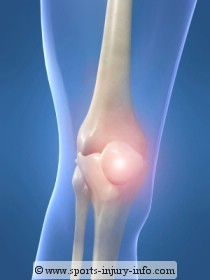PCL Knee Injury

PCL knee injury is a serious knee injury. It can occur with contact sports such as football or rugby, and can cause significant problems with the knee. It is not nearly as common as an ACL knee injury, but just as problematic.
What is the PCL?
The PCL, or posterior cruciate ligament, is one of the primary ligaments of the knee. It runs from the posterior aspect of the tibia to the anterior aspect of the femur.It crosses with the ACL within the knee, which is where it gets the name cruciate, or to cross.
The function of the pcl is to prevent the tibia from moving backwards under the femur. It provides posterior stability. In contrast, the ACL provides anterior stability, and keeps the tibia from moving forward under the femur. Together the ACL and the PCL keep the knee stable.
The
PCL becomes most tight during full knee flexion. As you will see, this
is the most common way that it is injured during sports.
How it is Injured
The most common way to injure the PCL is with forceful flexion, or bending of the knee. The sports related PCL knee injuries I have seen have all been with football players. They were either fallen upon, or tackled, forcing their knees to bend very forcefully, farther than they would normally bend. This forceful flexion places great stress on the PCL, and can lead to rupture.Another way that the PCL can be injured is with a forceful blow to the front of the tibia or lower leg. The amount of force needed to tear the PCL in this manner is not common with sports...however, it is with car accidents. I have seen several patients with PCL tears that were suffered during a car accident, where their knee hit the dashboard, and caused their PCL knee injury.
Symptoms of PCL Knee Injury
Swelling and pain are the most common symptoms of PCL knee injury. Swelling occurs almost immediately, within the first 10 minutes. This is because of the very vascular nature of the PCL, and the fact that when injured it bleeds quite a bit. It is located within the knee joint, so the fluid is contained. The knee will swell up all around the joint, and will look like a grapefruit.Learn more about swelling
As swelling occurs, this increases knee joint pressure, which causes pain. Much like other injuries, swelling is responsible for many of the symptoms associated with the injury. PCL knee injury is no different. Loss of motion and strength also occur, as a result of the swelling.
Instability, especially when moving from side to side, or rotating on the leg is common with PCL knee injury.
Treatment
R.I.C.E. is the first step in treating a PCL knee injury Rest, ice, compression, and elevation is needed in order to control swelling and pain immediately after injury. If you have any of the symptoms above, you need to see your physician or athletic trainer as soon as possible for further evaluation.They will take a history, and do some clinical tests to determine if you have injured your PCL. They may also recommend you undergo an MRI for further evaluation. You may have to be on crutches for a few days or weeks depending on the amount of pain you are having. You may also be placed in a knee brace to limit knee motion and allow the PCL to begin to heal.
While almost all ACL tears requre surgery, most PCL tears are treated conservatively initially. The use of a knee brace, rest, and rehabilitation can be effective in treating PCL knee injury. Focusing on improving the muscle function to help staiblize the knee can be successful. Your physician may recommend a derotation brace when you return to activity. Donjoy is one manufacturer that has I regularly recommend these braces to my patients.
PCL tears may need to be surgically repaired, depending on your activity levels and your symtpoms.
Summary
PCL knee injury is a serious knee injury, although not terribly common. It results from forced knee flexion, or a direct blow to the front of the low leg. PCL tears produce swelling, pain, loss of motion, and instability, and can be treated conservatively, but may require surgical intervention. If you think you may have torn your PCL, you need to see your physician or athletic trainer as soon as possible.Didn't find what you were looking for? Search SII for more information...
Running Pain Solutions
Written for Runners by a runner, you'll learn a holistic approach to improving mobility, restoring normal movement and muscle activation patterns, and restoring the body and mind connection.
This Kindle Book contains a step by step program to keep you running pain free. Included are detailed instructions and illustrations for exercises to improve mobility, balance, neuromuscular control, strength and endurance. Only $7.49!
Get Your Copy Today!









